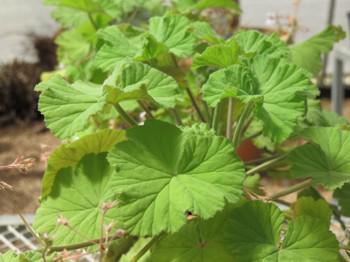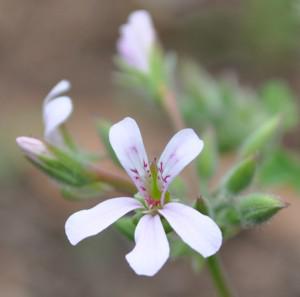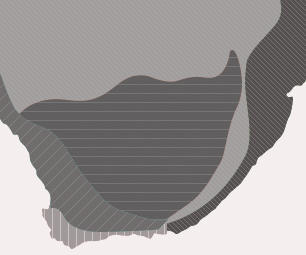Pelargonium album
Pelargonium album J.J.A v.d.Walt
Family: Geraniaceae
Common names: Pilgrim's Rest Pelargonium
Introduction
This is a striking plant with light green, fragrant foliage, suitable for the shady mixed border.

Description
Description
This is an upright perennial shrublet, 0.4 × 0.15 m, with an apple-minted scent. The semi-succulent stems are covered with the remains of the stipules. Young stems are green covered with glandular hairs; older stems turn brown and become glabrous. The leaves are simple and prominently veined. Both sides of the leaves are covered with glandular hairs. Leaves on the stems are larger than those on the flowering stems. The petiole has long and short glandular hairs which are interspersed with a few soft hairs. The stipules are triangular to bidentate.

The inflorescence is a flowering branch of several pseudo-umbels. Unbranched peduncle is 25–55 mm long, and terminates into a pseudo-umbel of 4–9(–15) flowers each. Involucral bracts are ovate, acute, membranous and covered with long, soft hairs. The pedicel is 3–12 mm long, with a thin covering of hair. The hypanthium is 9–20 mm long, distinctively thickened at the base and covered with long and short glandular hairs. The 5 sepals are apple-green with a white margin and vary from lanceolate to ovate. The petals are white, often with carmine markings.

Flowering is in winter to early summer (from June to November), reaching a peak in spring (September).
Conservation Status
Status
Pelargonium album has a status of Rare (Raimondo et al. 2009). It is believed that some subpopulations may have been lost due to forestry activities in the areas around Pilgrim’s Rest. The population is currently not suspected to be in decline, as there is no forestry-expansion.
Distribution and habitat
Distribution description
This species is limited to the area of Pilgrim’s Rest in Mpumalanga. It grows in humus-rich soils in shady, rock crevices on dolomitic hills of Northern Escarpment Dolomite Grassland. The area, a very-species-rich grassland-type and receives between 700–1 000 mm during the summer-months of the year.
Derivation of name and historical aspects
History
The genus Pelargonium, is derived from the Greek word pelargos because the fruit resembles the shape of the beak of a stork. The specific epithet album is derived from the Latin, meaning white and refers to the white flowers.
The genus Pelargonium belongs to the family Geraniaceae, a family of 11 genera and 800 species in the subtropical and tropical world. Other well-known genera includes: Geranium, Monsonia and Sarcocaulon. Pelargonium occurs in S, E and NE Africa, Australia, New Zealand, St Helena, Tristan da Cunha, Madagascar and Asia. Southern Africa is the hotspot of Pelargonium species and in the entire region, 219 of the 270 species are found.
This group of plants has been an attraction to collectors and travellers since the years of exploration in the 1600 and 1700s around the coast of the African continent. Plants were taken to Europe early in the 17th century where it became established in some of the gardens. Amongst the first species to end up in England was P. triste. The Dutch botanist Hermann, collected P. cucullatum on Table Mountain in 1672 and in 1690 this species was established at RBG Kew, London. In Leyden, the Netherlands, ten species were already on record in 1687. The much cultivated and bred ivy ‘geranium’ P. peltatum, was introduced to Dutch horticulture in 1700.
Ecology
Ecology
The light seed is a feathered, tail-like structure which is coiled in a spiral arrangement. The tail enables the seed to twist around in the wind and drills itself into the soil. This action ensures more seed have a better chance of germination.
Uses
Use
No cultural uses have been recorded
Pelargonium album is not well known in the horticultural trade.
Growing Pelargonium album
Grow
Pelargonium album can be propagated from cuttings. Cuttings can be made throughout the year, but the best results are obtained when they are taken after flowering or in early autumn. Take stem cuttings of 50–100 mm, cut below a node and dip in a rooting hormone. Place the cuttings firmly in prepared holes in a coarse river sand, rooting medium. The holes are made to prevent any damages to the ends of the cuttings.
The cuttings can now be placed in a cold frame or a position with enough light. The medium must be kept moist. Rooting takes 3–4 weeks. Once rooted, transplant the cuttings into a well-drained potting mix. Newly rooted cuttings can be fed with a liquid, seaweed-based fertilizer.
This pelargonium grows well where it gets exposed to moist, light shade for most of the day, in well-drained soil. Its velvety, light green leaves will burn in direct sunlight.
Compost or mulch can be added to help keep its roots cool. It has an almost lime-coloured foliage and its coarse texture should allow it to be exclusively cultivated as a textural plant only. The white flowers are small and insignificant.
It contrasts well with many fine-foliaged species, such as restios and species of Asparagus and Strelitzia. Plant it where it can be displayed with other fragrant Pelargonium spp. In light shade it performs also well with species of Clivia and Plectranthus.
References
- Dreyer, L. & Van der Walt, J.J.A. 1990. A new species from the Eastern Transvaal. South African Journal of Botany 56(1): 65–67.
- Mucina, L. & Rutherford, M.C. 2006. The vegetation of South Africa, Lesotho and Swaziland. Strelitzia 19. South African National Biodiversity Institute, Pretoria.
- Powrie, F. 1998. Grow South African Plants. A gardener's companion to indigenous plants. National Botanical Institute, Cape Town.
- Raimondo, D. et al. 2009. Red list of South African plants. Strelitzia 25. SANBI (South African National Biodiversity Institute), Pretoria.
- Stearn, W. 2002. Stearn's dictionary of plant names for gardeners. Timber Press, Portland, Oregon.
- Van der Walt, J J A. 1977. Pelargoniums of South Africa. Purnell, Cape Town.
Credits
Roger Oliver
Kirstenbosch National Botanical Garden
December 2014
Plant Attributes:
Plant Type: Ground Cover, Shrub
SA Distribution: Mpumalanga
Soil type: Loam
Flowering season: Spring, Winter
PH: Neutral
Flower colour: White
Aspect: Shade
Gardening skill: Easy
Special Features:
Horticultural zones









Rate this article
Article well written and informative
Rate this plant
Is this an interesting plant?
Login to add your Comment
Back to topNot registered yet? Click here to register.